A few weeks before I’d even heard about iNaturalist and the 2018 City Nature Challenge, I spied a peculiar lump of matter on the ground as I was mowing around a sextet of Washingtonian palms on our property.
I purposefully did not mow over the weird looking object. Earlier in the year, I’d overheard a volunteer from one of the Valley’s refuges talk about taking caution when tearing something apart that could be discovered in nature. After the group of people left him, I asked him what he was talking about.
He’d been talking about something that owls do. Then, VOILA! One appears on our property.
If you’ve followed my last two blogs, you’ll recall that Valley folks and a lot of our chapter members uploaded nature photographs to iNaturalist.org’s website database in order to document the diversity of the Valley’s habitat for the City Nature Challenge.
Signs-of-life photographs were accepted which included photos of feathers, roadkill, scat, and animal and bird tracks.
By now, I knew I wanted to include my peculiar something-left-behind-by-a-critter find in the iNaturalist count. I uploaded photos of three different ones from under the same palm.
To date, no one has confirmed my photos to be of owl pellets so I thought to see what information the Internet might have for me.
I discovered that owl pellets are composed of indigestible materials from the bird’s prey, including feathers, teeth, fur and some bones along with the owl’s digestive fluids.
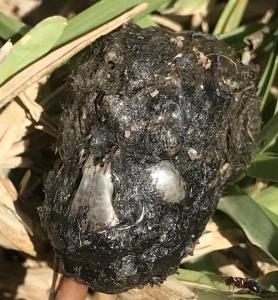
The pellets are not scat, as they have not passed through the owl’s digestive system, but have been regurgitated because they can’t be digested.
Owl intestines have weak digestive enzymes, according to one website, and cannot break down hard to digest materials. While digestible materials pass through, the rest is held in the owl’s gizzard. When full, an owl will stretch its neck up and forward, open its beak and eject the pellet without retching.
Owl pellets usually measure one and a half to three and a half inches long. When regurgitated, it is roughly the same shape as a particular owl’s gizzard and can be spherical, oblong or plug-shaped.
Maybe it’s my imagination playing tricks on me because this one caught my eye, not only because it was just sitting on a philodendron leaf beneath the palms, but it appeared to have a face and tail.
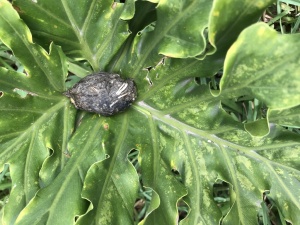
At first glance it looked to be a fish. Which wouldn’t have been a surprise.
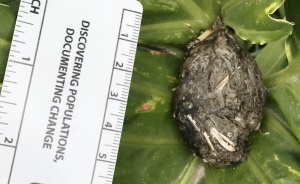
I’ve found a fish or two under a utility pole by our drive.
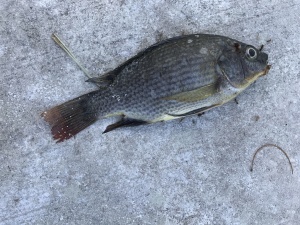
A Great Blue Heron has been known to perch atop the pole at night. It has left a fish at the base of the pole — whether because it was already full or it thought to share it with marauding raccoons. Mostly the bird just leaves a wash of white on the pavement.
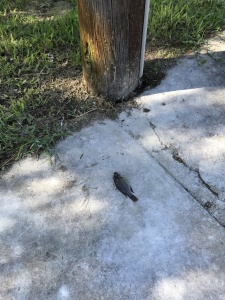
Barn owl pellets are easily recognized because barn owls’ diets consist primarily of rodents; therefore, those pellets are generally uniform in color, black when fresh, with obvious bits of other matter. The pellets gradually turn grey as they age. Other owls also eat other birds, doves, pigeons, and small songbirds. Some species of owls have diets that include fish, carrion or insects.
Most adult owls will produce two pellets a day. The pellets can easily be found underneath their favorite roosts. I don’t see that many around this stand of palms. Perhaps the owl has more than one roost. Earlier in the year, I’d see a barn owl fly out of a palm at the edge of the resaca and fly across to the trees on the other side. I suspect the pellets I find are those of a barn owl.
Apparently, these pellets are common to all birds of prey that swallow their food whole, including hawks and eagles. In falconry, it is called a casting. Other species that produce pellets include grebes, herons, cormorants, gulls, terns, kingfishers, crows, jays, swallows and most shorebirds.
Owl pellets have no smell. This is not the case with Turkey Vultures, who have the same ability of regurgitating undigested food. Some avian do this spontaneous regurgitation as a defense when startled or harassed. The extremely putrid-smelling vulture regurgitation can be ejected up to 10 feet and can burn its harasser since it is highly acidic. Herons, gulls, terns and kestrels also rely on this type of defense.
True to what I overheard the nature park volunteer tell a group of young people, I found the caution in a couple of places on the Internet.
Although owl pellets can be a fascinating find and interesting to pull apart to see what a bird’s diet was, it’s extremely wise to take caution before handling one.
Wearing medical gloves, wrap each pellet in aluminum foil and place it in a 325 degree F oven for forty minutes. This treatment should kill bacteria such as E. coli and other harmful things that might be present.
Personally, I would suggest wearing a mask if one goes so far as to have baked an owl pellet in order to dissect it. I may be overly cautious, but I suggest taking the pellet outside before breaking into it — in the event of airborne whatnot and all that.
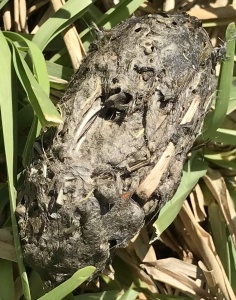
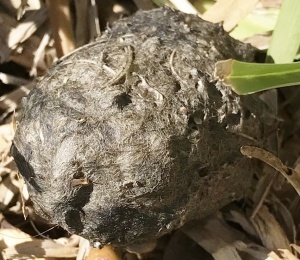
Who knew all of these things about owl pellets?!? Fascinating! I have seen them before, of course, and have heard about folks dissecting them, but never new the “how to’s” of the process. Thanks for sharing!
Indeed, who knew? If it weren’t for me being a journalist and schooled in eavesdropping on conversations, I would have never known. By the way, my owl has moved to a different Washingtonian Palm. I know this because the pellets are now under the different palm.